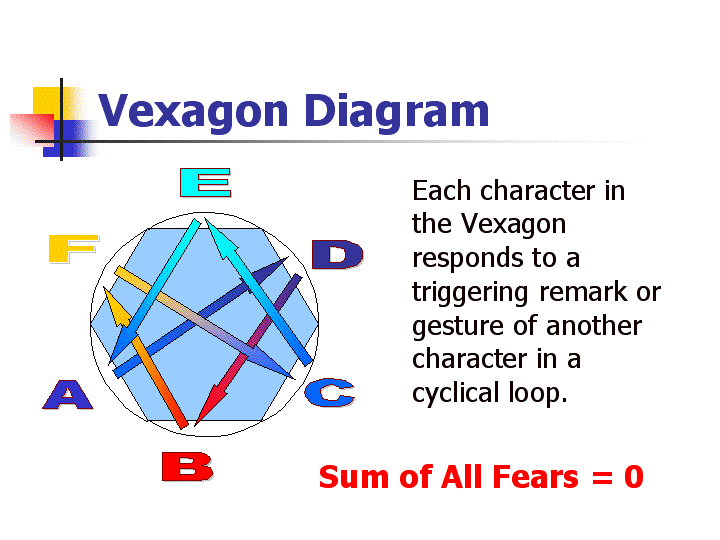
A story is an anecdote drawn from the culture. A well-crafted anecdote or story has value both as an amusement and as a source of insight into the world from which it is drawn. Since the plural of 'anecdote' is data, if you gather a large enough collection of anecdotal stories you ought to have a data base sufficient to model the culture from which the stories are drawn.
But first we need a functional model of StoryCraft. Before we can outline the plot structure of our story, we need to define the Characters who will play out our nasty little drama. The two primary characters in any drama are called Protagonist and Antagonist. Let's construct a simple model of them. Each character in a drama has a characteristic psychological profile. We propose modeling this profile in terms of eight basic psychological parameters: Fears, Emotions, Backstory, Issues, Beliefs, Practices, Desires, and Intentions, which drive the character's Actions/Reactions and Dramatic Life Story. This model concords with both Jungian analysis and existing models of Characterization in Drama Theory.
So, to elaborate, we have this Shreklisch Onion Layer Character Model, from the inside out:
1. Innermost Fears (Amygdala and Hippocampus)
2. Burbling Emotions (Limbic System)
3. Undisclosed Backstory (Long-Term Memory)
4. Burning Issues (Identify Fiend or Foof)
5. Sacred Beliefs (Neocortex)
6. Derivative Practices (Cerebellum)
7. Heart's Desires (HeartMind)
8. Avowed Intentions (Throat)
9. Foolish Actions & Reactions (Muscles)
10. Dreadful Drama (Shreklisch Life Story)
The Innermost Fears are the most fundamental (and deeply hidden) elements of the character's psychology. Swirling around the Innermost Fears are other Burbling Emotions which are generally acted out, but not necessarily mentioned by name. The character's Undisclosed Backstory establishes the basis for their dreads and associated unresolved problems. The Undisclosed Backstory explains the unresolved Burning Issues from the character's past. The Sacred Beliefs are the first important cognitive component of the character's psychology. Beliefs can be accurate or inaccurate as well as riddled with gaps. Associated with Beliefs are Derivative Practices, which correspond to the way the character handles (or fails to handle) recurring situations. Through the lens of the character's Belief System, he envisions his or her Heart's Desires. The Desires are the nominal inverse of the Fears and Dreads. The character believes that the object of desire will protect him from his dreads and alleviate his suffering. Among all his Heart's Desires, he undertakes to achieve at least one of them, and that becomes his Avowed Intention, his Holy Grail. That pursuit is the Opening Act of the unfolding Shreklisch Drama.
In order for the drama to get off the ground, the Protagonist and Antagonist must have Complementary Psychologies. The Desires and Intentions of the Protagonist must arouse the Fears of the Antagonist, and vice versa. This sets up the primary feedback loop that propels the conflict and the drama. To run a drama to Tragedy, it suffices that the characters consume their resources without resolving their conflict. Of all tragedies, perhaps the most complex are the Greek Tragedies which we may call Agonistic Drama. To run the drama to Comedy, something astonishing must happen. The characters must solve the Mystery of their long-suffering Agony and discover the system model we just presented. And, of course, so must the audience.
The central theorem of Drama Theory is called Clancy's Theorem, after one of Tom Clancy's book titles. But it's also inspired by one of Shakespeare's titles as well — Much Ado About Nothing.

References:
The Science Behind the Art of Teaching Science: Emotional State and Learning (Conference Paper in PDF Format)
The Vexagon Diagram (PowerPoint Slides)
Cognition, Affect, and Learning (Online Presentation and Discussion of the Above Paper and Slides)
Affective Learning Companion Project at the MIT Media Lab
Barry Kort's Emotions and Learning Jump Page (Where To Find Most Other Related Materials)
NSF ROLE Grant References (Comprehensive List of All References)
Bonus Musical Parody